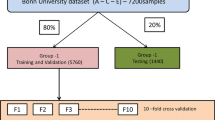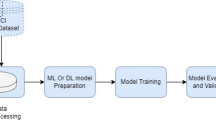Abstract
Epilepsy is a prevalent neurological disorder, which disturbs the lives of millions of people worldwide owing to the onset of abrupt seizures. The forecasting of seizures could help in protecting their lives by alerts or in clinical operations during epilepsy surgeries. The present paper addresses this problem by proposing a deep learning framework for prediction of epileptic seizures using intracranial EEG (iEEG) recordings. This framework performs filtering and segmentation of iEEG signals into 10s, 20s, 30s, 40s, 50s and 60s duration segments. These segments are further resolved into eight distinct spectral bands corresponding to delta, theta, alpha, beta and gamma sub-bands with frequency-domain transformation. Then, mean amplitude and band power features are extracted from each band, which are provided to convolutional neural network (CNN) and long short-term memory network (LSTM) algorithms for classification. The simulation results of the proposed CNN model exhibit higher performance with average accuracy, sensitivity, specificity, AUC and F1 score of 94.74%, 95.8%, 94.46%, 95.13% and 94.75% respectively for iEEG segments of 40s duration. Thus, the performance analysis and comparison with existing literature unveil that the proposed CNN model is an optimal approach for accurate and real-time prediction of epileptic seizures.














Similar content being viewed by others
References
AbdulGhaffar A, Mostafa SM, Alsaleh A, Sheltami TR, Shakshuki EM (2019) Internet of things based multiple disease monitoring and health improvement system. J Ambient Intell Human Comput:1–9
Acharya UR, Oh SL, Hagiwara Y, Tan JH, Adeli H (2018) Deep convolutional neural network for the automated detection and diagnosis of seizure using eeg signals. Comput Biol Med 100:270–278. https://doi.org/10.1016/j.compbiomed.2017.09.017
Akrivopoulos O, Amaxilatis D, Mavrommati I, Chatzigiannakis I (2019) Utilising fog computing for developing a person-centric heart monitoring system. J Ambient Intell Smart Environ 11(3):237–259
Aktas F, Ceken C, Erdemli YE (2018) Iot-based healthcare framework for biomedical applications. J Med Biol Eng 38(6):966–979
Albawi S, Mohammed TA, Al-Zawi S (2017) Understanding of a convolutional neural network. In: 2017 International Conference on Engineering and Technology (ICET), pp 1–6
Andrews JR, Arthur MG (1977) Spectrum amplitude: definition, generation, and measurement, vol 699. Department of Commerce, National Bureau of Standards, Institute for Basic Standards
Assi EB, Sawan M, Nguyen DK, Rihana S (2015) A hybrid mrmr-genetic based selection method for the prediction of epileptic seizures. In: 2015 IEEE Biomedical Circuits and Systems Conference (BioCAS). IEEE, pp 1–4
Baratloo A, Hosseini M, Negida A, El Ashal G (2015) Part 1: simple definition and calculation of accuracy, sensitivity and specificity. Emergency 3 (2):48–49
Berendt M, Høgenhaven H, Flagstad A, Dam M (1999) Electroencephalography in dogs with epilepsy: similarities between human and canine findings. Acta Neurol Scand 99(5):276–283. https://doi.org/10.1111/j.1600-0404.1999.tb00676.x
Boden M (2002) A guide to recurrent neural networks and backpropagation. the Dallas project
Brinkmann BH, Patterson EE, Vite C, Vasoli VM, Crepeau D, Stead M, Howbert JJ, Cherkassky V, Wagenaar JB, Litt B et al (2015) Forecasting seizures using intracranial eeg measures and svm in naturally occurring canine epilepsy. PloS one 10(8):e0133900
Cavanna AE (2011) Epilepsy and disorders of consciousness. Behav Neurol 24(1):1–1
Chandler K (2006) Canine epilepsy: What can we learn from human seizure disorders?. Vet J 172(2):207–217. https://doi.org/10.1016/j.tvjl.2005.07.001
Cho K-O, Jang H-J (2020) Comparison of different input modalities and network structures for deep learning-based seizure detection. Sci Rep 10(1):1–11
Darwish A, Hassanien AE, Elhoseny M, Sangaiah AK, Muhammad K (2017) The impact of the hybrid platform of internet of things and cloud computing on healthcare systems: Opportunities, challenges, and open problems. J Ambient Intell Human Comput:1–16
Dastjerdi AV, Buyya R (2016) Fog computing: Helping the internet of things realize its potential. Computer 49(8):112–116
Daud SS, Sudirman R (2015) Butterworth bandpass and stationary wavelet transform filter comparison for electroencephalography signal. In: 2015 6th International Conference on Intelligent Systems, Modelling and Simulation, pp 123–126
Debener S, Emkes R, De Vos M, Bleichner M (2015) Unobtrusive ambulatory eeg using a smartphone and flexible printed electrodes around the ear. Sci Rep 5:16743
Detti P, Vatti G, Zabalo Manrique de Lara G (2020) Eeg synchronization analysis for seizure prediction: A study on data of noninvasive recordings. Processes 8(7):846
Dhillon PK, Kalra S (2019) A secure multi-factor ecc based authentication scheme for cloud-iot based healthcare services. J Ambient Intell Smart Environ 11(2):149–164
Faust O, Hagiwara Y, Hong TJ, Lih OS, Acharya UR (2018) Deep learning for healthcare applications based on physiological signals: A review. Comput Methods Prog Biomed 161:1–13. https://doi.org/10.1016/j.cmpb.2018.04.005
Goodfellow I, Bengio Y, Courville A (2016) Deep learning. MIT press
Graves A, Schmidhuber J (2005) Framewise phoneme classification with bidirectional lstm and other neural network architectures. Neural Netw 18 (5):602–610. https://doi.org/10.1016/j.neunet.2005.06.042, IJCNN 2005
Greff K, Srivastava RK, Koutník J, Steunebrink BR, Schmidhuber J (2017) Lstm: A search space odyssey. IEEE Trans Neural Netw Learn Syst 28(10):2222–2232. https://doi.org/10.1109/TNNLS.2016.2582924
Hochreiter S, Schmidhuber J (November 1997) Long short-term memory. Neural Comput 9(8):1735–1780. https://doi.org/10.1162/neco.1997.9.8.1735
Howells FM, Temmingh HS, Hsieh JH, van Dijen AV, Baldwin DS, Stein DJ (2018) Electroencephalographic delta/alpha frequency activity differentiates psychotic disorders: a study of schizophrenia, bipolar disorder and methamphetamine-induced psychotic disorder. Transl Psych 8(1):75
Hughes JR (2008) Gamma, fast, and ultrafast waves of the brain: Their relationships with epilepsy and behavior. Epilepsy Behav 13(1):25–31. https://doi.org/10.1016/j.yebeh.2008.01.011
Hussein R, Ahmed MO, Ward R, Wang ZJ, Kuhlmann L, Guo Y (2019) Human intracranial eeg quantitative analysis and automatic feature learning for epileptic seizure prediction. arXiv:1904.03603
Hussein R, Lee S, Ward R, McKeown MJ (2020) Epileptic seizure prediction: A semi-dilated convolutional neural network architecture. arXiv:2007.11716
Islam SMR, Kwak D, Kabir MH, Hossain M, Kwak K (2015) The internet of things for health care: A comprehensive survey. IEEE Access 3:678–708
Kaggle (2014) Kaggle: American Epilepsy Society Seizure Prediction Challenge. https://www.kaggle.com/c/seizure-prediction/overview, Accessed: 2019-06-15
Kannathal N, Acharya UR, Lim CM, Sadasivan PK (2005) Characterization of eeg-a comparative study. Comput Methods Prog Biomed 80(1):17–23. https://doi.org/10.1016/j.cmpb.2005.06.005
Kovac S, Vakharia VN, Scott C, Diehl B (2017) Invasive epilepsy surgery evaluation. Seizure 44:125–136. https://doi.org/10.1016/j.seizure.2016.10.016, 25th Anniversary Issue
Kraemer FA, Braten AE, Tamkittikhun N, Palma D (2017) Fog computing in healthcare–a review and discussion. IEEE Access 5:9206–9222
Kuhlmann L, Lehnertz K, Richardson MP, Schelter B, Zaveri HP (2018) Seizure prediction-ready for a new era. Nat Rev Neurol 14(10):618–630
LeCun Y, Bengio Y, Hinton G (2015) Deep learning. Nature 521(7553):436
Liu C-L, Xiao B, Hsaio W-H, Tseng VS (2019) Epileptic seizure prediction with multi-view convolutional neural networks. IEEE Access 7:170352–170361
Ma X, Qiu S, Zhang Y, Lian X, He H (2018) Predicting epileptic seizures from intracranial eeg using lstm-based multi-task learning. In: Lai J-H, Liu C-L, Chen X, Zhou J, Tan T, Zheng N, Zha H (eds) Pattern Recognition and Computer Vision. Springer International Publishing, Cham, pp 157–167
Mora H, Gil D, Terol RM, Azorín J, Szymanski J (2017) An iot-based computational framework for healthcare monitoring in mobile environments. Sensors 17:10. https://doi.org/10.3390/s17102302
Moretti DV, Babiloni C, Binetti G, Cassetta E, Forno G D, Ferreric F, Ferri R, Lanuzza B, Miniussi C, Nobili F, Rodriguez G, Salinari S, Rossini PM (2004) Individual analysis of eeg frequency and band power in mild alzheimer’s disease. Clin Neurophysiol 115(2):299–308. https://doi.org/10.1016/S1388-2457(03)00345-6
Myers M, Threatt M, Solies KM, McFerrin BM, Hopf LB, Birdwell JD, Sillay KA (2016) Ambulatory seizure monitoring: From concept to prototype device. Ann Neurosci 23(2):100–111. https://doi.org/10.1159/000443567
Nejedly P, Kremen V, Sladky V, Nasseri M, Guragain H, Klimes P, Cimbalnik J, Varatharajah Y, Brinkmann BH, Worrell GA (2019) Deep-learning for seizure forecasting in canines with epilepsy. J Neural Eng 16(3):036031
NINDS (2019) Focus on epilepsy reearch: national institute of neurological disorders and stroke. https://www.ninds.nih.gov/Current-Research/Focus-Research/Focus-Epilepsy, Accessed: 2019-09-23
Panichev O, Popov A, Kharytonov V (2015) Patient-specific epileptic seizure prediction using correlation features. In: 2015 Signal Processing Symposium (SPSympo). IEEE, pp 1–5
Parvez MZ, Paul M (2014) Eeg signal classification using frequency band analysis towards epileptic seizure prediction. In: 16th Int’l Conf. Computer and Information Technology, pp 126–130
Robertson DGE, Dowling JJ (2003) Design and responses of butterworth and critically damped digital filters. J Electromyogr Kinesiol 13(6):569–573
Roy Y, Banville H, Albuquerque I, Gramfort A, Falk TH, Faubert J (2019) Deep learning-based electroencephalography analysis: a systematic review. J Neural Eng 16(5):051001
Salehinejad H, Sankar S, Barfett J, Colak E, Valaee S (2017) Recent advances in recurrent neural networks. arXiv:1801.01078
Samie F, Paul S, Bauer L, Henkel J (2018) Highly efficient and accurate seizure prediction on constrained iot devices. In: 2018 Design, Automation & Test in Europe Conference & Exhibition (DATE). IEEE, pp 955–960
Singh K, Malhotra J (2018) Stacked autoencoders based deep learning approach for automatic epileptic seizure detection. In: 2018 First International Conference on Secure Cyber Computing and Communication (ICSCCC), pp 249–254
Singh K, Malhotra J (2019) Iot and cloud computing based automatic epileptic seizure detection using hos features based random forest classification. J Ambient Intell Human Comput. https://doi.org/10.1007/s12652-019-01613-7
Singh K, Malhotra J (2021) Cloud based ensemble machine learning approach for smart detection of epileptic seizures using higher order spectral analysis. Physical Eng Sci Med:1–12
Singh K, Singh S, Malhotra J (2021) Spectral features based convolutional neural network for accurate and prompt identification of schizophrenic patients. Proc Inst Mech Eng Part H: J Eng Med 235(2):167–184
Subha DP, Joseph PK, Acharya UR, Lim CM (2010) Eeg signal analysis: A survey. J Med Syst 34(2):195–212. https://doi.org/10.1007/s10916-008-9231-z
Sun M, Wang F, Min T, Zang T, Wang Y (2018) Prediction for high risk clinical symptoms of epilepsy based on deep learning algorithm. IEEE Access 6:77596–77605
Suto J, Oniga S (2019) Efficiency investigation from shallow to deep neural network techniques in human activity recognition. Cogn Syst Res 54:37–49. https://doi.org/10.1016/j.cogsys.2018.11.009
Truong ND, Nguyen AD, Kuhlmann L, Bonyadi MR, Yang J, Ippolito S, Kavehei O (2018) Convolutional neural networks for seizure prediction using intracranial and scalp electroencephalogram. Neural Netw 105:104–111. https://doi.org/10.1016/j.neunet.2018.04.018
Tsipouras MG (2019) Spectral information of eeg signals with respect to epilepsy classification. EURASIP J Adv Signal Process 2019(1):10. https://doi.org/10.1186/s13634-019-0606-8
Wang Y, Yan J, Wen J, Yu T, Li X (2016) An intracranial electroencephalography (ieeg) brain function mapping tool with an application to epilepsy surgery evaluation. Front Neuroinform 10:15. https://doi.org/10.3389/fninf.2016.00015
WHO (2019) Epilepsy: World Health Organization. https://www.who.int/mentalhealth/, Accessed: 2019-10-23
Yamashita R, Nishio M, Do RKG, Togashi K (2018) Convolutional neural networks: an overview and application in radiology. Insights Into Imaging 9(4):611–629. https://doi.org/10.1007/s13244-018-0639-9
Yao X, Cheng Q, Zhang G-Q (2019) A novel independent rnn approach to classification of seizures against non-seizures. arXiv:1903.09326
Zhang J, Tian J, Cao Y, Yang Y, Xu X, Wen C (2019) Fine-grained ecg classification based on deep cnn and online decision fusion. arXiv:1901.06469
Zhou M, Tian C, Cao R, Wang B, Niu Y, Hu T, Guo H, Xiang J (2018) Epileptic seizure detection based on eeg signals and cnn. Front Neuroinform 12:95. https://doi.org/10.3389/fninf.2018.00095
Author information
Authors and Affiliations
Corresponding author
Ethics declarations
Ethical Approval
The present research work involve the use of publicly available Kaggle’s American Epilepsy Society Seizure Prediction Challenge dataset of intracranial EEG signals, which was jointly developed by University of Pennsylvania and the Mayo Clinic. This competition was sponsored by the National Institutes of Health (NINDS), the Epilepsy Foundation, and the American Epilepsy Society. All applicable international, national, and/or institutional guidelines for the care and use of animals were followed. All procedures performed in studies involving human participants were in accordance with the ethical standards of the institutional and/or national research committee and with the 1964 Helsinki declaration and its later amendments or comparable ethical standards.
Informed Consent
Since the data used in this study is open access dataset. Therefore, informed consent was obtained by the developers of data from all individual participants included in the study.
Conflict of Interests
The authors declare that they have no conflict of interest.
Additional information
Publisher’s note
Springer Nature remains neutral with regard to jurisdictional claims in published maps and institutional affiliations.
Rights and permissions
About this article
Cite this article
Singh, K., Malhotra, J. Prediction of epileptic seizures from spectral features of intracranial eeg recordings using deep learning approach. Multimed Tools Appl 81, 28875–28898 (2022). https://doi.org/10.1007/s11042-022-12611-x
Received:
Revised:
Accepted:
Published:
Issue Date:
DOI: https://doi.org/10.1007/s11042-022-12611-x




